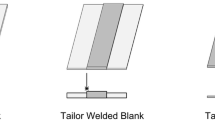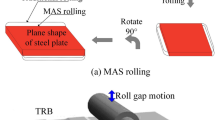Abstract
A new model suitable for both asymmetrical and symmetrical tailor rolled blank (TRB) rolling is proposed by the slab method. In the transition zone of TRB, the work roll moves up or down during the rolling process to carry out variable gauge rolling (VGR). The difference of rolling pressure between VGR and conventional rolling is analyzed. The results reveal that the rolling pressure, rolling force, and rolling torques in downward rolling are larger than those in conventional rolling, while in upward rolling phase, they are less than in the conventional rolling. The variance between VGR and conventional rolling is related to the transition zone shape factor and roll radius. A larger transition zone shape factor results in a more significant difference between VGR and conventional rolling. The effect of roll speed ratio on mechanical parameters during the VGR is nearly identical to that observed in conventional rolling. With the increase of roll speed ratio, the thickness ratio of TRB increases. The VGR force calculated using proposed model agrees well with the experimental values, with a maximum error of 9.7%.


















Similar content being viewed by others
Data availability
Data will be made available on request.
Code availability
Not applicable.
Abbreviations
- l :
-
Length of the completed part in a cycle unit during the VGR process
- l h, l t, l b :
-
Lengths of thick zone, transition zone, and thin zone in the TRB, respectively
- h d :
-
Thickness difference between the thick zone and thin zone
- h 1, h 2 :
-
Thicknesses of thick zone and thin zone in the TRB, respectively
- θ :
-
Angle between transition zone and horizontal line
- P :
-
Rolling force per unit width in conventional rolling
- P′(l), P″(l) :
-
Rolling force per unit width in downward and the upward rolling, respectively, when the completed rolling length in a cycle unit during VGR process is l
- p 1, p 2 :
-
Rolling pressures of the lower and upper rolls, respectively
- p x, σ x :
-
Vertical and horizontal stresses in the deformation zone, respectively
- σ f, σ b :
-
Front and back tension, respectively
- f 1, f 2 :
-
Friction coefficients of the lower and upper rolls, respectively
- i :
-
Roll speed ratio
- K :
-
Plane deformation resistance
- h x(l):
-
Variable strip thickness in the deformation zone, when the completed rolling length in a cycle Unit during VGR process is l
- h' x(l), h" x(l):
-
Variable strip thickness in the deformation zone in downward and upward rolling, respectively, when the completed rolling length in a cycle unit during VGR process is l
- H, h :
-
Thicknesses at the entrance and exit of deformation zone in conventional rolling, respectively
- h(l):
-
Thickness at the nominal exit of deformation zone in transition zone, when the completed rolling length in a cycle unit during VGR process is l
- h'(l), h"(l):
-
Thicknesses at the actual exit of deformation zone in the downward rolling and upward rolling, when the completed rolling length in a cycle unit during VGR process is l, respectively
- Δh :
-
Reduction in the conventional rolling
- Δh(l):
-
Nominal reduction in the transition zone, when the completed rolling length in a cycle unit during VGR process is l
- Δh"(l):
-
Actual reduction in the upward rolling, when the completed rolling length in a cycle unit during VGR process is l
- α, α', α" :
-
Contact angles in the conventional rolling, downward rolling, and upward rolling, respectively
- L(l), L(l)', L(l)" :
-
Contact lengths of deformation zone in conventional rolling, downward rolling, and upward rolling, respectively
- T 1, T 2 :
-
Rolling torques of lower and upper rolls, respectively
- R :
-
Radius of the work roll
- V 1, V 2 :
-
Peripheral speeds of lower and upper rolls, respectively
- v y :
-
Speed of upper roll, when the completed rolling length in a cycle unit during VGR process is l
- v x :
-
Speed of rolled piece at the nominal exit of the deformation zone, when the completed rolling length in a cycle unit during the VGR process is l
References
Zhi Y, Wang XG, Wang S, Liu XH (2017) A review on the rolling technology of shape flat products. Int J Adv Manuf Technol 94(9–12):4507–4518. https://doi.org/10.1007/s00170-017-1004-8
Merklein M, Johannes M, Lechner M, Kuppert A (2014) A review on tailored blanks—production, applications and evaluation. J Mater Proc Technol 214(2):151–164. https://doi.org/10.1016/j.jmatprotec.2013.08.015
Daamen M, Dávalos Julca D, Hirt G (2014) Tailored strips by welding, strip profile rolling and twin roll casting. Adv Mater Res 907:29–39. https://doi.org/10.4028/www.scientific.net/AMR.907.29
Kopp R, Böhlke P (2003) A new rolling process for strips with a defined cross section. CIRP Ann 52(1):197–200. https://doi.org/10.1016/s0007-8506(07)60564-2
Kopp R, Wiedner C, Meyer A (2005) Flexibly rolled sheet metal and its use in sheet metal forming. Adv Mater Res 6–8:81–92. https://doi.org/10.4028/www.scientific.net/AMR.6-8.81
Vidoni M, Daamen M, Gastreich J, Offermanns N, Hirt G (2014) Hot rolling of AISI 304 tailored strips produced by twin roll strip casting. Prod Eng 8(5):619–626. https://doi.org/10.1007/s11740-014-0567-6
Wang XG, Liu XH (2018) Variable thickness rolling—a new process for rolled profile strips. Key Eng Mater 792:47–52. https://doi.org/10.4028/www.scientific.net/KEM.792.47
Wang XG, Liu XH, Wang S, Zhi Y (2018) Analysis and experiment on rolling of strips with various thicknesses in lateral direction. Int J Mech Sci 141:393–400. https://doi.org/10.1016/j.ijmecsci.2018.03.033
Wang XG, Liu XH, Wang S, Zhi Y (2018) Experiment and simulation to rolled profile strip with variable thicknesses in lateral direction. J Mater Proc Technol 258:259–270. https://doi.org/10.1016/j.jmatprotec.2018.03.028
Wang XG, Wang S, Liu XH (2020) Variable thickness rolling of plates thick in the middle and thin on the sides. J Mater Proc Technol 277:116432. https://doi.org/10.1016/j.jmatprotec.2019.116432
Ryabkov N, Jackel F, van Putten K, Hirt G (2008) Production of blanks with thickness transitions in longitudinal and lateral direction through 3D-Strip Profile Rolling. Int J Mater Form 1(S1):391–394. https://doi.org/10.1007/s12289-008-0077-1
Wang S, Wang XG, Liu XH, Li CS (2021) Experiment and simulation of variable thickness rolling for 3D-profiled blank. J Mater Proc Technol 290:116971. https://doi.org/10.1016/j.jmatprotec.2020.116971
Liu XH, Zhang GJ, Zhi Y (2013) On the law of mass conservation for variable gauge rolling. Chin Sci Bull 58(18):1769–1774. https://doi.org/10.1360/972012-132
Liu XH, Zhang GJ (2012) Force equilibrium differential equations for variable gauge rolling. J Iron Steel Res Int 24(4):10–18. https://doi.org/10.13228/j.boyuan.issn1001-0963.2012.04.002
Liu XH (2011) Prospects for variable gauge rolling: technology, theory and application. J Iron Steel Res Int 18(1):1–7. https://doi.org/10.1016/S1006-706X(11)60001-0
Zhang GJ, Liu XH (2011) Research on roll force for variable gauge rolling. Adv Mater Res 418–420:1232–1236. https://doi.org/10.4028/www.scientific.net/AMR.418-420.1232
Zhang SJ, Liu XH, Liu LZ (2018) A tensile specimen of tailor rolled blanks with equal probability in yield and its mechanical behavior analysis. Materials 11(5):693–711. https://doi.org/10.3390/ma11050693
Zhang SJ, Hu XL, Niu CL, Misra RDK, Yan S, Liu XH (2020) Annealing of HC340LA tailor rolled blanks—control of mechanical properties and formability. J Mater Proc Technol 281:116581. https://doi.org/10.1016/j.jmatprotec.2019.116581
Wang J, Liu XH, Guo WP (2018) Analysis of mechanical parameters for asymmetrical strip rolling by slab method. Int J Adv Manuf Technol 98(9–12):2297–2309. https://doi.org/10.1007/s00170-018-2368-0
Wang J, Liu XH, Sun XK (2020) Study on the relationship between asymmetrical rolling deformation zone configuration and rolling parameters. Int J Mech Sci 187:105905. https://doi.org/10.1016/j.ijmecsci.2020.105905
Funding
The authors declare that no funds, grants, or other support were received during the preparation of thismanuscript.
Author information
Authors and Affiliations
Contributions
Ji Wang: conceptualization, methodology, writing—original draft, formal analysis, investigation, validation, and visualization. Xianlei Hu: resources, writing—review and editing, and supervision. Xue Feng: investigation and validation.
Corresponding authors
Ethics declarations
Ethics approval
Not applicable.
Consent to participate
All authors have consented to participate in this study.
Consent for publication
We confirm that this work is original and has not been published elsewhere, nor is it currently under consideration for publication elsewhere. All the authors listed have agreed to publish the manuscript that is enclosed.
Competing interests
The authors declare no competing interests.
Additional information
Publisher's Note
Springer Nature remains neutral with regard to jurisdictional claims in published maps and institutional affiliations.
Rights and permissions
Springer Nature or its licensor (e.g. a society or other partner) holds exclusive rights to this article under a publishing agreement with the author(s) or other rightsholder(s); author self-archiving of the accepted manuscript version of this article is solely governed by the terms of such publishing agreement and applicable law.
About this article
Cite this article
Wang, J., Hu, X. & Feng, X. Study on an analytical model of asymmetrical and symmetrical tailor rolled blank rolling. Int J Adv Manuf Technol (2024). https://doi.org/10.1007/s00170-024-13579-8
Received:
Accepted:
Published:
DOI: https://doi.org/10.1007/s00170-024-13579-8




